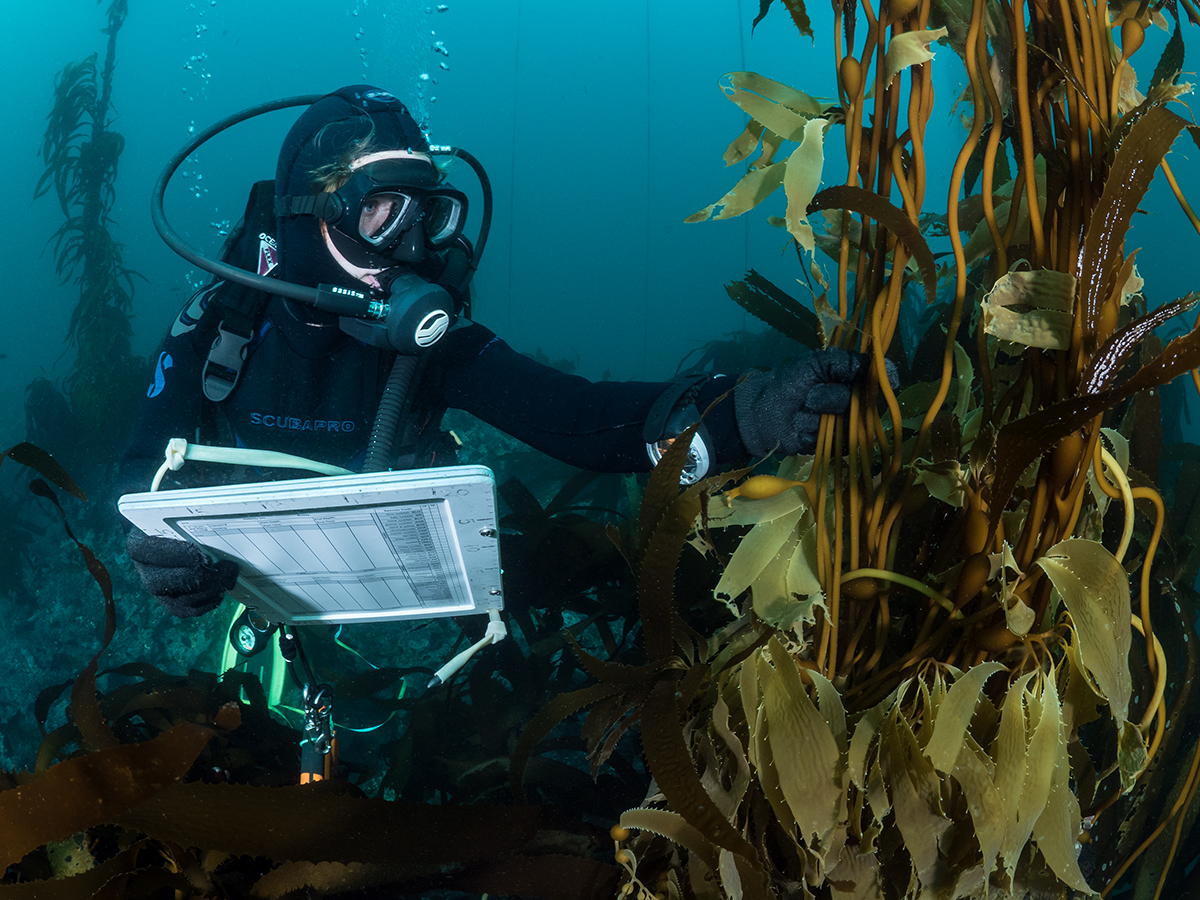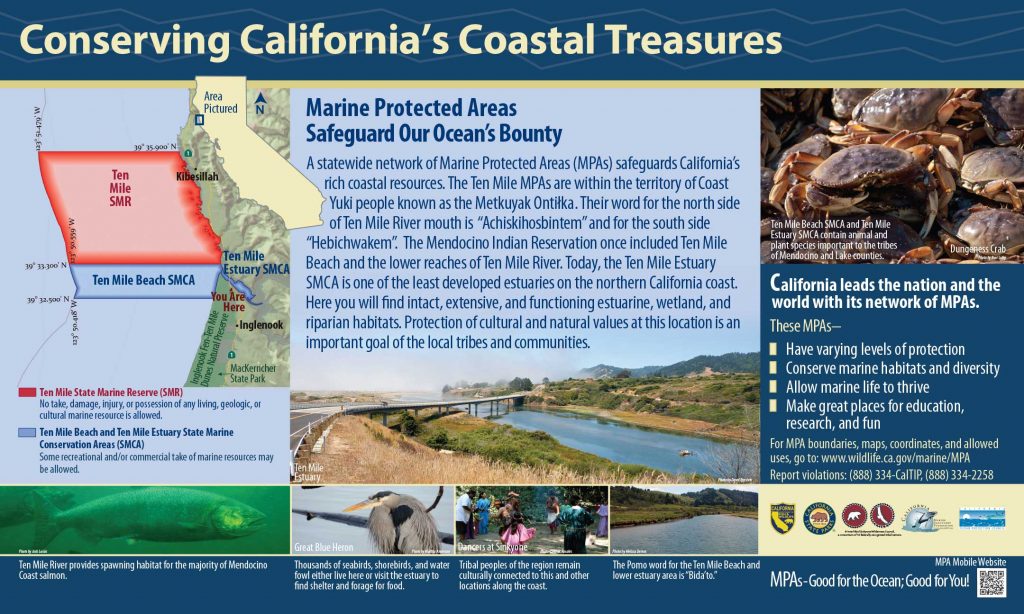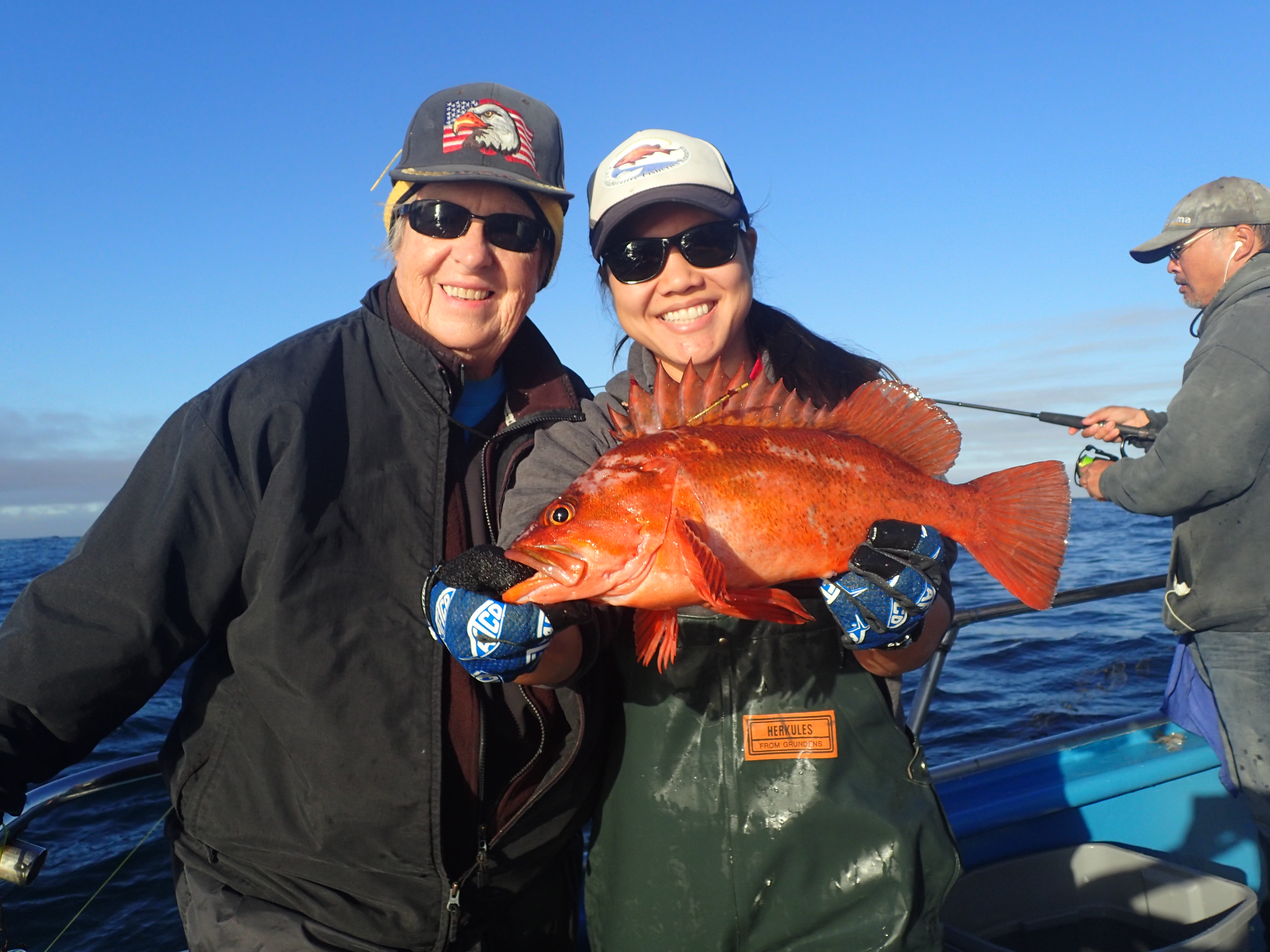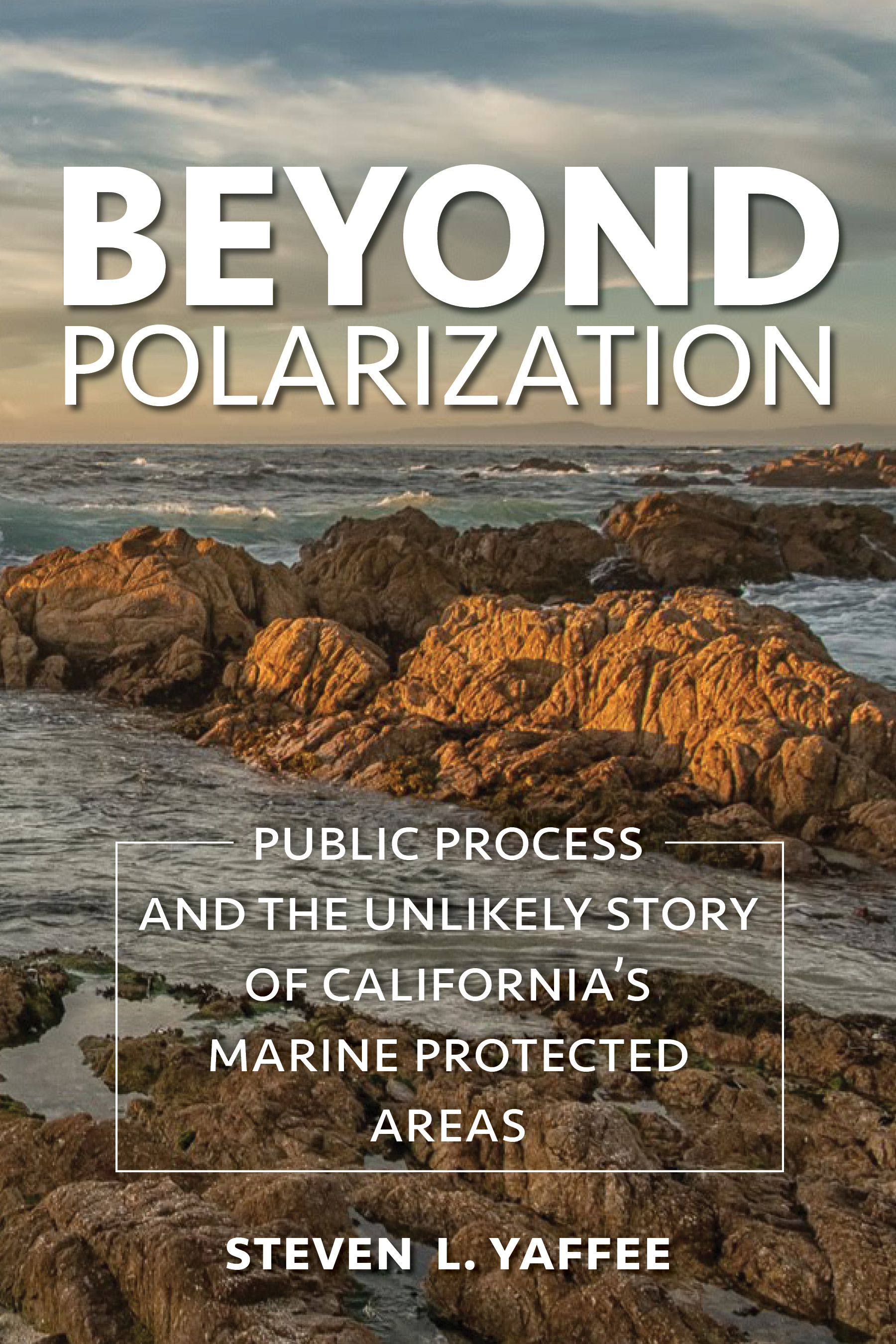Editor’s note: In 2012, the US state of California formally adopted a statewide network of 124 marine protected areas (MPAs), covering over 16% of state waters. A new book Beyond Polarization: Public Process and the Unlikely Story of California's Marine Protected Areas analyzes what allowed the California Marine Life Protection Act (MLPA) Initiative to succeed in a time of political polarization and fiscal constraint. We interviewed book author Steven Yaffee and process participant Kaitilin Gaffney to get their perspectives about the MLPA Initiative and how conservation action can be achieved at times of political polarization. Yaffee is a professor of natural resources and environmental policy at the University of Michigan, and Gaffney is director of the Ocean, Coast, and Fisheries Program at the Resources Legacy Fund, which oversaw the MLPA Initiative, a public-private partnership between the state of California and philanthropic donors. She participated in the MLPA Initiative as director of the Pacific Program of Ocean Conservancy.
Skimmer: What were some of the major factors that created polarization at the time that the California MLPA Initiative was going on, and what were some of the major factors that enabled the California MLPA Initiative to succeed?
Yaffee: Part of the book’s subtitle is “the Unlikely Story of the California MPAs,” and at many points throughout the MPA planning process known as the “MLPA  Initiative,” it
Initiative,” it
seemed incredibly unlikely that it would produce MPA designations on the water. There was intense conflict over competing uses and the values associated with marine ecosystems, which promoted polarization between the human representatives of those values. In many places, the situation felt very zero-sum, that is, outcomes that would provide gains to one interest would necessarily create losses to another. Win-lose situations are highly competitive and likely to lead to impasse, since it appears that there can be no gains from a collaborative approach.
Reinforcing this tendency to inaction was the fact that California’s MPA planning occurred during the Great Recession. The “we can’t afford it” argument was used by MPA opponents and their political allies to press back against continuing the planning process, as were many other arguments: MPAs are unnecessary; have too high an economic cost; and won’t end pollution or slow coastal development. MPA proponents and opponents formed active coalitions outside of the formal public process to influence outcomes. These coalitions mobilized hundreds of people on all sides of the issue, crowding public hearing venues and generating media headlines. The most likely outcome of this level of visible conflict was that political officials would pull back from a commitment to MPAs.
In addition, the science of MPA networks was not well-established during California’s planning process, which enabled MPA opponents to argue that uncertain benefits did not warrant potential costs. Some state agency staff were reluctant to embrace MPAs or share control over the MPA planning process. Critically, historic state policies that failed to recognize the unique harvesting rights of Native American Tribes and tribal communities became barriers to progress and could have derailed the whole effort.
With conditions like these, it is rare to get past impasse and achieve durable outcomes. The book details what happened, but here are a few of the factors promoting success. First, the 1999 Marine Life Protection Act settled the question of whether there would be new MPAs. While fisheries interests tried to relitigate this question throughout the first three years of the MLPA Initiative, the law was clear: there would be new MPAs and ecosystem protection would take priority. The law did not require minimizing economic impacts, which reduced the power of MPA opponents. However, there was intense political pressure to consider economic impacts in MPA design. As a result, Ecotrust was hired by the Initiative to project “worst case” economic impacts. While no one was fully satisfied by their data, it did exceed the information assembled by the state in previous efforts. One way or the other, having information on economic values – expressed in the Ecotrust data and by the fishermen themselves – incentivized MPA proponents to do their best to accommodate fishing industry concerns.
Second, the scientific advisors to the MLPA Initiative defined a set of simple rules of thumb for MPA design, which enabled stakeholders to create their own MPA plans, based on the scientific guidelines and fostered a greater sense of understanding and ownership over MPAs. The law’s requirement that the process use “best readily available science,” undercut MPA opponents’ arguments that more information was needed before making decisions, a common delay tactic in public decision making.
Third, the MLPA Initiative was a unique public-private partnership that mobilized US$38 million in funding from both state and philanthropic sources to support the process. This partnership provided flexibility and creativity that bypassed the normal bureaucratic conditions that often bog down public decision making. The Initiative was carefully designed to be both accountable and effective, so that it was transparent, inclusive, and firewalled from control by private interests. At the same time, the partnership enabled an extraordinary level of public engagement, while building the political will to move forward.
Fourth, strategic public process was deployed through four sequential regional planning processes to enable learning and adaptation to the unique conditions along the long and varied California coast. Good facilitators brought lots of tools to the table; representatives of a broad range of stakeholder groups were carefully chosen by facilitators and state officials to promote collaborative engagement; and the overall structure of the Initiative created effective linkages and boundaries between policymakers, scientists, and stakeholders.
Overall, the process mobilized and empowered a diverse set of people to engage directly in decision making in a manner that was unusual in public policy. The use of a collaborative geographic information system enabled diverse interests to design alternative MPA networks together, shifting the dynamic from conflict between people on different sides of a negotiating table to problem-solving focused on common data and a shared space. Relationships were built among representatives of different stakeholder groups, enabling enough trust to develop to foster interest-based bargaining.
None of this was perfect; mistakes were made; science guidelines were not met in some regions; and exhaustive iterative process was frustrating to all. Still, from this set of carefully thought-out conditions, California gained a significant legacy, not the least of which was the sense that people can work together to solve shared problems even in polarized times.
Gaffney: California has a 1,000-mile coastline with diverse habitats ranging from sandy beaches, tidepools, and estuaries, to lush kelp forests and deep-sea canyons. Native American communities have relied on and stewarded ocean and coastal resources for over 14,000 years. California has a current population of nearly 40 million people and a coastal tourism-based economy worth more than US$17 billion annually. Millions of visitors come each year to enjoy its beaches, surf, sail, kayak, SCUBA dive, swim, and appreciate its abundant seabirds, marine mammals, and other ocean wildlife. Hundreds of commercial fisherman harvest over 300 different species of fish and invertebrates off the California coast, and more than 250,000 ocean specific fishing licenses are sold in southern California alone each year. Clearly, California’s coast and ocean provide many different values to many different users, so getting agreement on which areas to protect and how to protect them was an inherently challenging task.
As Steve (Yaffee) noted, after the MLPA was signed into law, state agencies struggled to carry out the law in the face of budget limitations, scientific uncertainty, and hostility from fishing groups. After two initial attempts to implement the law stalled, in 2004, Resources Legacy Fund, supported by several philanthropic donors, signed a formal agreement with the State of California to coordinate an MPA planning process designed specifically to ensure the broadest public input and to reach an outcome based on the best-available science.
As Steve has noted, critical factors for overcoming polarization included:
- The clear legal mandate provided by the Marine Life Protection Act statute itself
- Strong and consistent political leadership from the highest levels of state government over many years
- An inclusive and science-based planning process that empowered stakeholders with the responsibility of MPA design
- A public-private partnership that provided financial resources but also focused oversight and management to ensure deadlines were met and outcomes achieved.
I would add to this list a final major factor leading to California’s success: it was able to draw upon the time and talent of an exceptional group of dozens of civic and community leaders from state and Tribal government and the scientific, fishing, recreation, business, and conservation communities. This group set aside personal interests, rolled up their sleeves, and worked together over an eight year period to craft the first-in-nation MPA network and then committed to the even harder task of continuing to work together to manage this MPA network effectively and cooperatively over time.
Skimmer: We are currently experiencing intense polarization – around political philosophies, belief in mainstream science, etc. – in the natural resource management and conservation field today. Do you feel that the nature of polarization around marine conservation and management has changed in the last decade?
Yaffee: It is hard to separate the decision-making context of marine conservation from more general trends over the last decade. Research confirms what we all  experience daily – that changes in social media and telecommunications have led to cultural shifts that exacerbate conflict and hamper understanding. A voracious, instantaneous news cycle has driven out conditions associated with thoughtful, responsible decision making. When decision makers are constantly under the spotlight, it is hard to find room for well-meaning people to learn about issues and agree on strategies to move forward.
experience daily – that changes in social media and telecommunications have led to cultural shifts that exacerbate conflict and hamper understanding. A voracious, instantaneous news cycle has driven out conditions associated with thoughtful, responsible decision making. When decision makers are constantly under the spotlight, it is hard to find room for well-meaning people to learn about issues and agree on strategies to move forward.
Information overload and the need for our single-tasking brains to multitask have affected our ability to focus rigorously on complex problems. Because people can choose among competing facts, our cognitive biases lead us to believe information that fits our preconceptions and support ideas that become linked to identities – political party, special interest faction, etc. All of this combines to promote a sense of “us versus them,” where creative middle ground solutions seem unlikely. It drives out people and organizations occupying the “strategic middle,” which fosters connections and searches for practical solutions to get past impasse and craft agreements.
While these forces affect progress on all kinds of issues, marine conservation has suffered from shifts in “boundary-spanning” institutions. Much of the story of marine ecosystem-based management and marine spatial planning has been a story of combining information and conducting planning and collaborative action at larger scales. However, a decline in federal leadership on ecosystem-scale ocean policy has reduced some of the incentives for effective transboundary action.
While these changes in culture and governance have developed measurably over the last decade, numerous opportunities and incentives exist to promote integrative decision making. As Julia Wondolleck and I catalogued in our 2017 book Marine Ecosystem-Based Management in Practice: Different Pathways, Common Lessons and is described in detail in Beyond Polarization, examples of successful collaborative decision making exist. Enough research has taken place so that we have a rich understanding of the factors that enable it. Great tools exist for collaborative planning and research. An understanding of large-scale issues like sea level rise and climate justice can be used as “common enemies” to mobilize forces across geographies and cultures. Plus, otters, sea lions, kelp forests, reefs, and healthy coastal communities provide powerful images that can empower a shared search for ways forward.
The decline in federal leadership has opened the possibility for innovation and creativity from other sources: state and local government, regional groups of agencies and governors, innovative coalitions and partnerships, and international institutions. Conservation entrepreneurs can leverage these countervailing forces against the societal forces that are promoting polarization and impasse and can craft the understanding and will to act. At times, their efforts may feel like swimming upstream against very strong currents, but as is seen in the creation of the California MPAs, the ends are worth it.
Gaffney: Unfortunately, as Steve notes, at the federal level, polarization has gotten much worse in the past few years and there have been significant rollbacks of bedrock environmental laws and regulations and gutting of key protections for marine and land national monuments.
By contrast, in California, we have been fortunate to see business and conservation interests and bipartisan voices willing to come together around some key conservation issues like climate legislation and banning new offshore oil drilling. While the MPA network planning process was at times very contentious, over the past decade a strong partnership approach to managing the new protected areas has emerged. We now have sport and commercial fishermen active in scientific monitoring of MPAs, state park rangers providing an online MPA curriculum to tens of thousands of school children, and the state providing funds for a Tribal Marine Stewards Network pilot project to support tribal engagement in MPA monitoring and stewardship. Over the past decade, California has been able to convert much of the historic polarization around MPAs into constructive engagement on a range of ocean management issues.
One great example is the MPA Collaborative Network which was formed in 2013, just after the statewide MPA network was completed. Stakeholders were so heavily involved in the MPA design phase that there was a strong interest in ensuring local constituents could continue to have a voice in the ongoing management of their local MPAs. Now 14 county-based “Collaboratives” provide a forum for nonprofits, fishermen, tribal representatives, government staff, municipalities, academic institutions, citizen scientists, teachers, aquariums, and others to work together to enhance awareness and understanding about MPAs, promote their appropriate use, and ensure compliance with MPA regulations. By working together, these diverse stakeholders have built common ground that has benefits that extend far beyond MPAs.
Skimmer: Could the California MLPA Initiative succeed now?
Gaffney: California’s MPA network is one of the state’s most significant conservation success stories, and it built upon a long history of conservation leadership in the  state. Passage of the Marine Life Protection Act itself had bipartisan support in the state legislature, and the state’s MPA planning process was launched under Republican Governor Arnold Schwarzenegger, completed under Democratic Governor Jerry Brown, and is now being implemented under Democratic Governor Gavin Newsom. As Beyond Polarization makes clear, MPA planning in California was complex and at times controversial, with differing viewpoints about the value of MPAs, the best places to protect, and the most appropriate regulations to apply.
state. Passage of the Marine Life Protection Act itself had bipartisan support in the state legislature, and the state’s MPA planning process was launched under Republican Governor Arnold Schwarzenegger, completed under Democratic Governor Jerry Brown, and is now being implemented under Democratic Governor Gavin Newsom. As Beyond Polarization makes clear, MPA planning in California was complex and at times controversial, with differing viewpoints about the value of MPAs, the best places to protect, and the most appropriate regulations to apply.
That said, Californians love their coast. And while public support for MPAs was high when the Marine Life Protection Act was passed in 1999, it has grown in recent years. The 2020 annual survey on Californians and the Environment conducted by the Public Policy Institute of California found that more than ninety percent of Californians say that the condition of the ocean and beaches is important to California’s future economy and quality of life and that they support maintaining existing rules and boundaries for national marine sanctuaries and MPAs. This support spans political parties, gender, age, ethnicities, and inland as well as coastal geographies. There has also been an ever-growing body of international science and policy supporting MPAs as a necessary tool for protecting biodiversity, particularly given the serious and growing impacts of climate change on ocean ecosystems and species. International experts are now calling for 30% of ocean waters to be protected in MPAs. California was ahead of the curve when it adopted a science-based network of MPAs more than two decades ago, but if it had not done so then, I am confident it would be doing so now.
Yaffee: It is hard to run history backwards, and some of today’s conditions represent direct or indirect outcomes of the MLPA Initiative. New data, science, and tools were sponsored by the Initiative and helped it move forward. Advocates were empowered, and institutional and leadership changes at the state level co-evolved with the Initiative. Absent the eight years of the Initiative, some of these elements might not be in place, though others – particularly the MPA science and tools, state support for environmental values, and national and international recognition of the value of MPAs — would have developed on their own and would have accelerated a push for MPA designation.
Several unique aspects of today’s context might have made it harder: federal agencies that were supportive of new MPAs during the Initiative might have been directed to obstruct the process and the forces that have heightened polarization (described above) might have made opposition campaigns more successful. Plus, if we add in the pandemic, a limited ability to build face-to-face relationships over meals and through negotiations might have made collaborative decision making harder, even with the distance-shrinking magic of Zoom. Still, Kaitilin (Gaffney) is absolutely right that the bottom-line conditions in California that fostered action – a strong identity with the coast; motivated political leadership; philanthropic, scientific and conservation communities that are extraordinarily capable, among others – would have likely combined to enable a designation process today.
Skimmer: Based on your experiences with the California MLPA Initiative as well as other conservation and management initiatives, what suggestions do you have for today’s practitioners for achieving conservation and management policy success?
Gaffney: At the global level we are facing what feel like unprecedented challenges on so many fronts: a pandemic, an economic crisis, continued racial and social  injustice, and the existential threat of climate change. While the sheer number and severity of these crises could be paralyzing, history shows us that even in the most difficult times, leadership and vision can advance large-scale environmental successes with far-reaching ecological, social, and economic benefits. During the Great Depression, newly elected President Franklin D. Roosevelt established the Civilian Conservation Corps and put millions of Americans to work on environmental projects, aiding economic and social recovery by creating new jobs and developing new skills, but also making lasting contributions to forest management, flood control, and the development of state and national parks. During this period of extreme economic hardship, the federal government took steps to protect areas now included in Kings Canyon, Olympic, Dry Tortugas, Isle Royale, Capitol Reef, and Channel Islands National Parks.
injustice, and the existential threat of climate change. While the sheer number and severity of these crises could be paralyzing, history shows us that even in the most difficult times, leadership and vision can advance large-scale environmental successes with far-reaching ecological, social, and economic benefits. During the Great Depression, newly elected President Franklin D. Roosevelt established the Civilian Conservation Corps and put millions of Americans to work on environmental projects, aiding economic and social recovery by creating new jobs and developing new skills, but also making lasting contributions to forest management, flood control, and the development of state and national parks. During this period of extreme economic hardship, the federal government took steps to protect areas now included in Kings Canyon, Olympic, Dry Tortugas, Isle Royale, Capitol Reef, and Channel Islands National Parks.
The MLPA Initiative is another great example of the truism that times of great challenge also present opportunities for leadership. Amid widespread layoffs and the precipitous plunge of our nation’s economy during the Great Recession, philanthropic partners committed support to the MLPA Initiative. Key gubernatorial, legislative, and agency leaders kept an eye on the MLPA Initiative’s long-term goals and were steadfast in their support, even when faced with political opposition and serious fiscal challenges. In 2012, California completed the first MPA network in the nation, protecting almost 17 percent of state’s nearshore ocean waters and that investment is now paying dividends in healthier, more resilient ecosystems; diversified coastal economies; and rebounding fisheries. Other states and nations are now looking to California’s example as they explore plans to protect their ocean resources.
I encourage colleagues seeking to advance conservation in these daunting times to be bold, to prioritize long-term planning, to seek to leverage private funds with public resources, to pursue partnership with the broadest possible array of allies, and to fully address equity and social justice to ensure conservation benefits to all.
Yaffee: I appreciate Kaitilin’s call for bold, visionary leadership even in these daunting times. Indeed, with the possibility of major political change not too far in the future, I am more hopeful today that we will see a recommitment to a set of shared public values leading to significant public policy shifts. While the MLPA Initiative represented the kind of outside-the-box, visionary efforts that Kaitilin calls for, I would note that vision and leadership on their own are not enough. The Initiative drew on the creative, strategic, and very hard work of many people, many of whom paid close attention to the details of moving from vision to impact.
If there is one subtext of the story told in Beyond Polarization, it is that Process Matters! And process leaders and agency staff need to improve their skills at crafting and managing complex science-intensive, conflict-laden processes. It is not enough to get a law framed well or secure a solid scientific basis for decision-making. Building effective relationships and institutions; developing the understanding, capacity, and motivation of agency staff and stakeholders; supporting and energizing their creative efforts; and mobilizing the political will to follow through are all critical to achieving change. Julia Wondolleck and I have pointed to the importance of both the “bricks” and the “mortar” of conservation. The bricks are the seemingly tangible elements such as organizational structures, laws, and science; the mortar emphasizes the motivation, commitment, and energy that sticks all of this together to achieve outcomes. Both are needed to achieve success. Beyond Polarization tells the rich saga of how one effort in California put all of this together. People seeking to achieve transformative change elsewhere should learn from its history, which is an unlikely but ultimately empowering story.
Interested in learning more? OCTO (The Skimmer’s parent organization) recently hosted a webinar with Steven Yaffee and Kaitilin Gaffney on the new book Beyond Polarization and the MLPA Initiative.
Figure credits:
Figure 1: Intertidal MPA monitoring, PISCO.
Figure 2: Kelp forest MPA monitoring, Reef Check California.
Figure 3: Interpretive MPA signage
Figure 4: Cooperative MPA monitoring program with recreational fishermen, CCFRP Moss Landing.
Figure 5: Beyond Polarization book cover.
